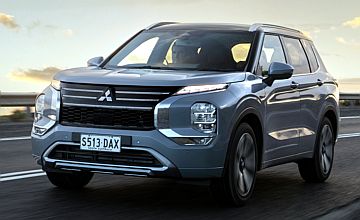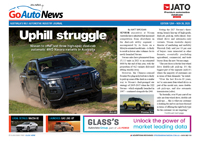Make / Model Search
OptionsCar reviews - Mitsubishi - OutlanderMitsubishi modelsOverviewWe like Appealing exterior and cabin design, straightforward HMI, smarter steering response, improved country road ride, quality audio systems, useful online connectivity tech, reasonably good value Room for improvement Mediocre acceleration yet overzealous throttle take-up, loud engine, relative thirst, harsh urban ride on 20-inch wheels, varying ESC response, lacks a non-plugged hybrid or turbo petrol option Mitsubishi revitalises popular midsize Outlander SUV10 Jul 2025 By TOM BAKER Overview
DESPITE battening down the hatches as it prepares for regulatory and commercial headwinds to whip the Australian car industry, Mitsubishi Motors Australia Limited (MMAL) has poured considerable resources into an early revitalisation program to its best-selling model—the Outlander midsize SUV.
On top of aesthetic and specification tinsel expected at facelift time, the upgrades have centred around altered suspension hardware and steering software developed in response to feedback from a reactivated MMAL local ride and handling program that has returned to the Magna’s old tuning locations of Lang Lang, Victoria, and regional South Australia.
Tokyo-based Mitsubishi Motors Corporation (MMC) regarded Australia’s adjusted Outlander spec to be so impressive it has adopted the changes at the global production level for all markets in a coup to MMAL’s power standing within the junior Renault-Nissan Alliance brand.
Added sophistication doesn’t normally come free, and it hasn’t—with pricing for the 2.5-litre petrol engine line-up increasing by five to nine per cent in real terms to $39,990-$57,990 plus on-road costs, accounting for deletion of a third row from posh Exceed and Exceed Tourer grades. Family-orientated LS and Aspire remain a standard 5+2 proposition.
But the fleet-focused, sub-$40K ES benefits most from the upgrades, retaining its touring-friendly 18-inch alloys but gaining twin 12.3-inch displays, wireless Apple CarPlay/Android Auto, and an eight-speaker Yamaha Premium stereo alongside automatic LED headlights, cloth trim, manual front seats and navigation with DAB/AM/FM radio.
LS ($43,290+ORCs) keeps 18s and cloth seats, but adds the helpful stowaway third row, privacy glass, roof rails, passive entry, leather steering wheel/gear shifter, and new Mitsubishi Connect networking with a companion smartphone app for remote unlocking, climate control, location and trip data.
Leaping to the mid-tier Aspire ($47,790+ORCs) adds machined 20-inch alloy wheels with uprated Bridgestone Alenza rubber, microsuede/Granluxe seats (heated in front, power for the driver), heated steering wheel, and heads-up display while keeping the 5+2 layout.
AWD costs $2500 on ES/LS/Aspire, but it becomes standard on the pair of Exceed grades which lose their third row in what MMAL claims reflects the preferences of their typically empty-nester buyers, who prefer a bigger boot and full-size alloy spare of the five-seat configuration.
At $55,140+ORCs, the Exceed adds leather, front seat ventilation and memory, a panoramic sunroof, third climate zone, auto-tilting mirrors and a digital rear view mirror while the $58K Exceed Tourer completes the spec’ with massaging front seats, heated rear pews, a black roof and a stunningly clear 12-speaker Yamaha Ultimate stereo.
Beyond AWD, colours are the sole option, attracting $740 or $940 upcharges depending on hue; black interiors are generally standard, though the Exceed offers a light grey (NCO), while the two-tone Exceed Tourer is only trimmed with Brick Brown leather. Deleted for now is the LS Black Edition grade, though it could return later.
Fuel efficiency for the 2.5-litre powertrain depends on trim, with official numbers ranging from 7.5L/100km-8.1L/100km; associated CO2 emissions are 170-185g/km. Fuel capacity is 55 litres and the Outlander accepts 91-octane fuel. The impressive PHEV option returns in September with greater power and electric range, though pricing is to be announced.
Servicing within MMAL’s network every 12 months/15,000km allow buyers to annually extend the standard warranty of five years/100,000 kilometres to 10 years/200,000km. The first five qualifying services average $340; the back five average $528 a pop.
Driving impressions
The ‘ZM’ Outlander has never set dynamic benchmarks among midsize SUVs, and according to MMAL, this crossover (based on the Alliance’s CMF-C/D platform) was always intended to appeal to family and downsizer buyers seeking a comfort bias.
However, initial iterations were frequently criticised for excessive impact harshness on Australian roads, vague handling, and the mediocrity of the performance and fuel efficiency of the standard 2.5-litre ‘PR25DD’ naturally-aspirated petrol four-cylinder engine.
While an optional ‘4B12’ 2.4-litre petrol/dual electric motor plug-in hybrid solved the regular Outlander’s accelerative issues, its additional mass coupled with the Mitsubishi’s underdamped suspension (finalised during COVID shutdowns) meant it was even less satisfying on Aussie roads.
The dynamic shortcomings of the fourth-gen’ Outlander have been confounding, due to the placid nature of the same platform in the (smaller) Nissan X-Trail, and the use of MacPherson-type strut front and multi-link independent rear suspension. Certainly, the tuning of the KYB-supplied shock absorbers and electronic power steering was not right.
Both issues have been attacked within MMAL’s local chassis program, with the piston of the rear shocks altered while changes have been made to the bump/rebound action and spring rates front and rear. A thinner front anti-roll bar has been substituted in while an all-new EPS steering map reduces the centre dead-zone and slows overall steering response.
The changes to the steering meaningfully improve fluency on a flowing country road and the suspension changes have made a difference—just not a very substantial one. Back-to-back driving revealed a reduction in head toss and fidget but rear-end heave over crests is still disturbing while low-speed impact harshness suspends the serenity.
We might be being a touch harsh as the only MY25 Outlanders available for our sampling rode on 20-inch wheels and in pre-facelift form, ES and LS on 18s always offered upgraded compliance. Still, the desirable trims still ought to ride better. Rigidity also seems in short supply.
We’d also like to see MMAL teams get stuck into improving brake pedal feel, the at-times belated electronic stability control intervention, and the unnecessarily raring-to-go step-off acceleration characteristics of the CVT automatic, which wants to flare revs to the stratosphere immediately.
And as the ride and handling are incrementally improved, the dreary 2.5-litre Nissan-sourced petrol stands out further as being well behind the standard-fit hybrid of a Toyota RAV4, the turbo-petrol found in a Skoda Kodiaq, or even the workmanlike PHEV systems increasingly proliferating into affordable Chinese crossovers.
Its acceleration is flaccid, and its fuel efficiency (9.1L/100km on test, for 604km range) unimpressive, offset only by the fact that the Outlander’s price of entry continues to be some thousands below equivalent trims of the more fluent Kia Sorento, Hyundai Santa Fe, or the aforementioned Skoda Kodiaq.
None of which is the fault of MMAL’s chassis team, which has meaningfully improved the middling Outlander but who came along too late to properly influence the core dynamics of this four-year-old vehicle. We look forward to seeing their more comprehensive future efforts from closer to scratch.
Where Mitsubishi deserves high praise is in its pragmatic approach to interior design, with the Outlander’s straightforward dashboard incorporating up-to-date technology that is easy to use—alarmingly rare in 2025. Hard buttons and dials are retained for climate, audio and steering wheel controls and they work well.
Range-wide fitment of high-definition 12.3-inch screens is remarkably democratic, though we’d still try for LS and upward to get the benefit of connected-car tech (such as remote climate activation for hot days) and expected niceties at this price like a leather wheel.
Comfortable seats, plentiful oddment storage, reasonable-quality finishes and space-galore in the second row make the Outlander a liveable family vehicle if the ride suits you. The ‘5+2’ third row of LS and Aspire is very compact but is undoubtedly handy when you’re in a pinch, stowing into a boot measuring 478 litres (485L in five-seat trims).
Subjectively, the Outlander has handsome proportions only improved by the MY25 update, which mainly adds clear, darkened tail-lights and better-looking wheels—even if we wish the low-profile 20-inch version was a more sensible 19, which would immediately improve ride quality.
With the exception of strong lane keeping assistance, which is made standard from Aspire upward, every other safety feature is fitted by default including forwards and reversing AEB, adaptive cruise control, blind spot monitoring and a clear 360-degree camera that makes parking—and seeing obstacles while doing so—a doddle.
Unfortunately, the driver attention monitoring (DAM) module that first arrived on the Triton now afflicts the Outlander, and while MMAL’s alterations to Triton’s DAM sensitivity have flowed to this SUV, it is still oversensitive, and it requires several taps to turn off.
In framing Mitsubishi’s status locally, MMAL chief executive Shaun Westcott told GoAuto he is content for the brand to be a solid three- or four-star hotel—not five, not one. That seems about right for the Outlander: it does lack the polish you’d get from the Four Seasons, but despite a price rise, it is still charging Novotel money.
Among non-luxury SUVs, the full-service offer increasingly looks Czech, or South Korean. Compared to Chinese rivals like the considerably cheaper Chery Tiggo 8 Pro Max, the Mitsubishi’s straightforward approach, extensive dealer network and even the sprinkling of a few frills for MY25 look somewhat appealing.
 All car reviews Alfa Romeo Alfa Romeo Abarth Abarth Audi Audi Aston Martin Aston Martin BMW BMW Bentley Bentley Chrysler Chrysler Chevrolet Chevrolet Dodge Dodge Citroen Citroen Ferrari Ferrari DS DS Ford Ford Fiat Fiat FPV FPV Foton Foton Haval Haval Great Wall Great Wall Honda Honda Holden Holden Hyundai Hyundai HSV HSV Isuzu Isuzu Infiniti Infiniti Jaguar Jaguar Iveco Iveco Kia Kia Jeep Jeep Land Rover Land Rover Lamborghini Lamborghini Maserati Maserati Lexus Lexus McLaren McLaren Mazda Mazda Mercedes-Benz Mercedes-Benz Mitsubishi Mitsubishi Mini Mini Opel Opel Nissan Nissan Porsche Porsche Peugeot Peugeot Ram Ram Proton Proton Rolls-Royce Rolls-Royce Renault Renault Skoda Skoda Saab Saab SsangYong SsangYong Smart Smart Suzuki Suzuki Subaru Subaru Toyota Toyota Tesla Tesla Volvo Volvo |
OptionsClick to share
|









Facebook Twitter Instagram